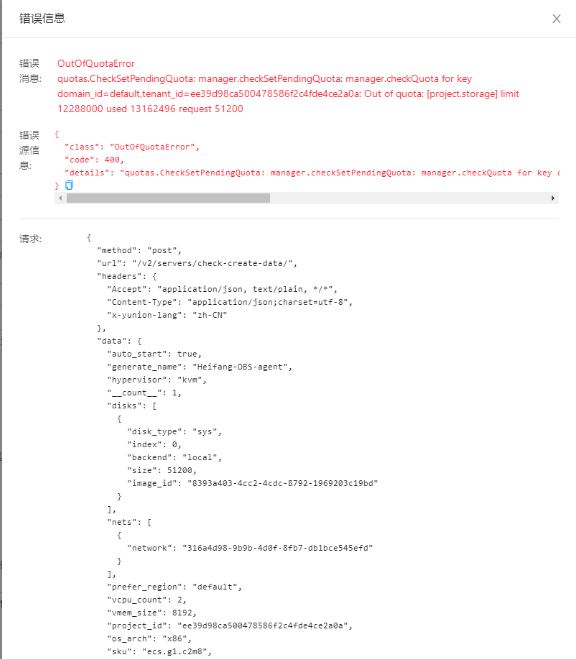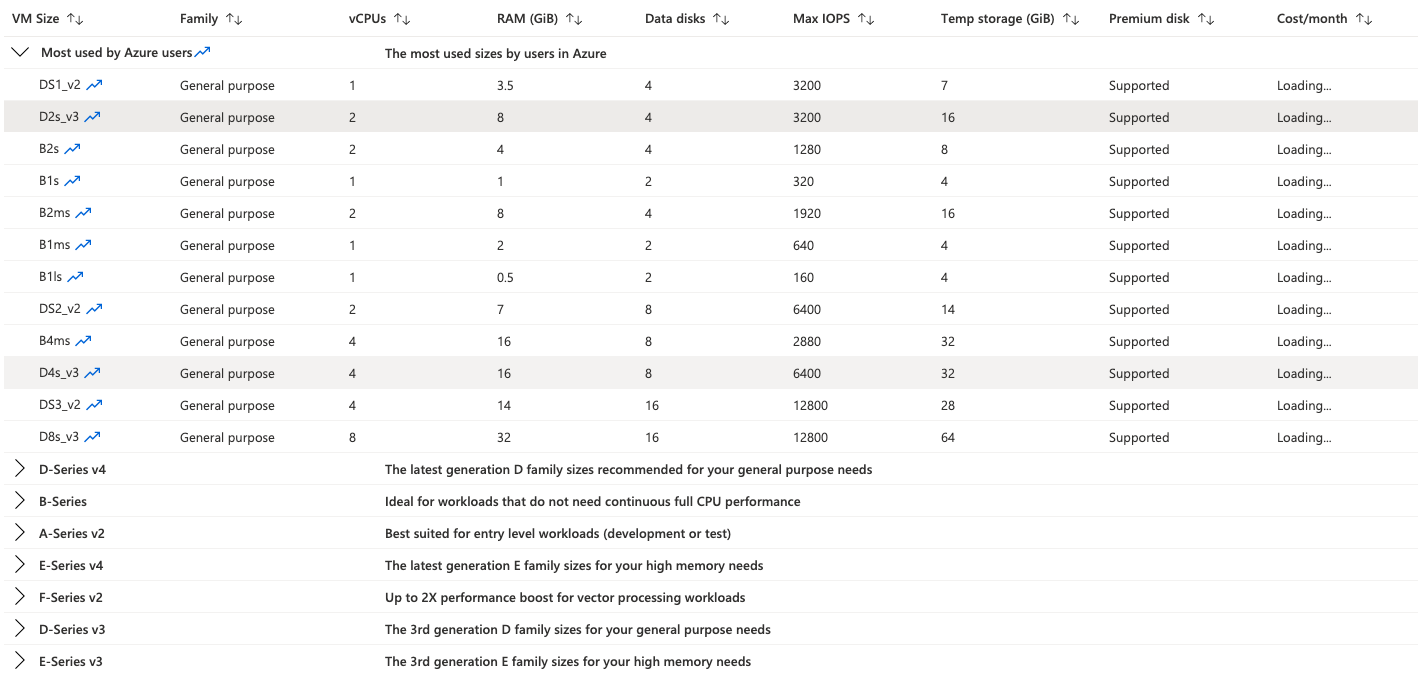Cloud Resources
What capabilities does Compute Resource Management have?
It includes the lifecycle management of servers and baremetal, including creation, modification, deletion, startup and shutdown operations.
What capabilities are available for storage resource management?
This includes the creation, mounting, unmounting, expansion, and deletion of virtual disks, as well as the creation, rollback, and purging of snapshots.
What are the capabilities of image resource management?
Support for image creation (import and upload of images from the image market), modification, deletion and other operations, support for distributed image caching and cross-platform image compatibility capabilities, etc.
Summary of reasons for failure of new server scenarios
quota error
When the error reason indicates “OutQuotaError”, the following error message is reported.


This type of error is reported as insufficient quota for the project where the server is created. Quota is used to artificially control the amount of resources in the project, you can adjust the quota of resources in the project details - quota usage or turn off quota checking in the global settings.
Adjust quota

Disable quota checking

resources error
When the error reason suggests “OutofResource”, this class reports an error about insufficient resources to create a server. The user needs to check if there is enough space on the host, network, storage, etc. to create a server, etc.
How do I modify the retention time of deleted hosts and cloud drives in the trash?
The OneCloud platform provides the function of trash for hosts and disks. When the hosts and disks are deleted, the hosts and disks will be automatically deleted after they remain in the trash for a period of time, and the default is to retain them for 3 days. The retention time of hosts in the trash can be modified and set as follows.
Remotely connect to the control node via ssh and use the climc command to modify the retention time of hosts and disks in the trash.
# Modify the retention time of hosts and disks for one week with the parameter value in s. 604800 = 7*24*60.
$ climc service-config --config pending_delete_expire_seconds=604800 region2
Wait about 5 minutes for the setting to take effect. Or delete the pod where the image is located and restart the image service.
$ kubectl get pods -n onecloud |grep region
$ kubectl delete pods <region-pod-name> -n onecloud
How do I change the retention time of a deleted image in the trash?
The OneCloud platform provides a image trash feature, when a image is deleted, the image will remain in the image trash. The image in the trash will not be deleted automatically, but you can manually set the retention time of the image in the trash by setting the following.
Connect to the control node remotely via ssh and use the climc command to modify the retention time of the image in the trash.
# Modify the retention time of the image for one week, the parameter value is in s, 604800 = 7*24*60.
$ climc service-config --config pending_delete_expire_seconds=604800 glance
After setting, wait for about 5 minutes to take effect. Or delete the pod where the image is located to restart the image service.
$ kubectl get pods -n onecloud |grep glance
$ kubectl delete pods <glance-pod-name> -n onecloud
Since the deletion time of images in the trash is not available on the OneCloud platform, you need to use the climc command on the control node to see if the automatic deletion of images is as expected.
$ climc image-show <image-namge/image-id>
# image-name, image-id are the name and id of the image in the trash
Field | Value
auto_delete_at | 2019-08-20T09:14:47.000000Z # Image auto-delete time
Why can’t I open the image market?
Common reasons.
- Server time zone or time is not correct, resulting in OSS API not working properly.
- The network is not accessible to Alibaba Cloud OSS (Object Storage Service, Object Storage) Beijing.
Why is there a minimum limit for the server system disk?
The Server system disk minimum value is determined by the following aspects, if the following 3 points are met at the same time, the system disk minimum value is the maximum value of the following settings.
- The partition size in the system image is set when the image is created, and cannot be changed after the image is created.
- the system has a DefaultDiskSizeMB parameter, which was 30GB by default before 2.6, but has been changed to 10GB by default, and this parameter can be modified through the configuration file.
- The public cloud has a minimum limit for the system disk of the server, e.g. the minimum system disk of Tencent Cloud is 50GB.
The server failed to start with the error “qemu-system-x86_64: cannot set up guest memory ‘pc.ram’: Cannot allocate memory”, how to solve it?
The problem is caused by insufficient host memory, please increase the host memory or shut down other servers on the host.
Why does it always fail to create a server on the public cloud Alibaba Cloud platform?
There are mainly the following reasons.
-
Insufficient Alibaba Cloud account balance. When creating a pay-per-use host on the CMP, the Alibaba Cloud account balance is required to be greater than 100 CNY.
SDK.ServerError ErrorCode: InvalidAccountStatus.NotEnoughBalance Message: Your account does not have enough balance. -
Alibaba Cloud account does not have the permission to import ESC image from OSS. Checking the system logs, you can see the following error message. For this type of new Alibaba Cloud account, you need to add the role permission to import ECS images from OSS on Alibaba Cloud console. Generally speaking, the CMP will set the permission automatically through Alibaba Cloud RAM API.
SDK.ServerError ErrorCode: NoSetRoletoECSServiceAcount Message: ECS service account Have no right to access your OSS.please attach a role of access your oss to ECS service account.- Login to Alibaba Cloud, select “Monitoring & Management > Access Control > Role Management”, click “Create Role” button to bring up the setting dialog.
- select the role type as “Service Role”, select the type as “ESC Server”, and set the role name as AliyunECSImageImportDefaultRole.
- Click the “Create” button to create the role.
- After the role is created, enter the Create Authorization Policy page.
- Select “Exact Authorization”, enter the policy name “Alibaba CloudECSImageImportRolePolicy”, and click the “OK” button to save.
- This sets the permission for the account to import ESC images from OSS.
-
The Alibaba Cloud account does not have OSS service enabled.
oss: service returned error: StatusCode=403, ErrorCode=UserDisable, ErrorMessage=UserDisableLogin to Alibaba Cloud platform and open OSS service.

Why does creating a server on the Microsoft Azure platform always fail on the CMP?
Mainly because of the following reasons.
-
The Microsoft Azure Platform package includes a limit on the number of disks, but the package information on the Cloud Management Platform only shows information about CPU and memory. Please set the number of Azure disks according to the package restrictions on disks on the Azure platform when creating an Azure server.

Why do I get a disk error creation error when creating a VMware server on the CMP?
The possible reason is that the esxiagent cannot access the ports of the ESXi hosts. You need to allow the esxiagent to be able to access the following ports of all managed esxi hosts.
- TCP 443
- TCP 902
The list of ports that need to be open for the VMware platform can be found in the VMware official website documentation.
What is the difference between snapshot and image?
The difference between the two is shown in the following table.
| Operation | Difference | Application Scenario |
|---|---|---|
| Snapshots | Snapshots preserve the complete state of the host disk at a point in time, do not take up much space, and can be created or deleted quickly. A host created based on a snapshot retains the personalized information of the original host and is a complete copy (clone) of the original host. | Data Recovery |
| Images | A image is a pre-processed copy of a server disk. Pre-processing includes user data cleanup, disk compression, elimination of personalization information (host ID, key), etc. | Application Distribution |
Why is there an injected public key file in the Server created or nano-managed on the CMP?
Reason: The public key file of the server is injected by the platform and will inject both a global and a project level public key file to the server. The private key is stored in the control node, and the user can view the key file via the Climc command.
# View Key pairs, --admin means the global key; --project means view the project key.
$ climc sshkeypair-show --admin
$ climc sshkeypair-show --project <project-name>
Application Scenario: By injecting the public key file, the Web SSH function of the server on the CMP can log in to the server as cloudroot user password-free. The subsequent automated operation and maintenance function of the platform is also based on this function.